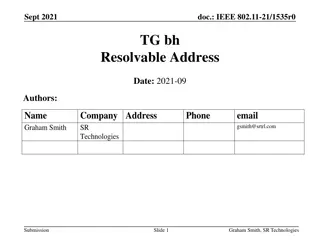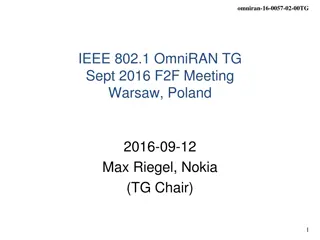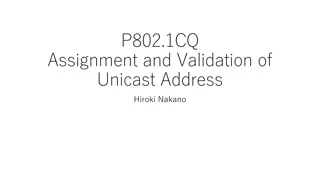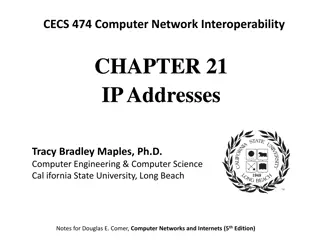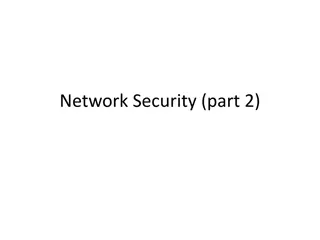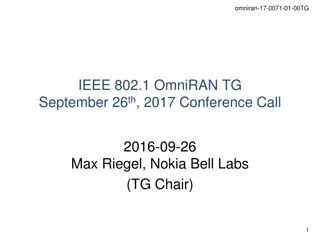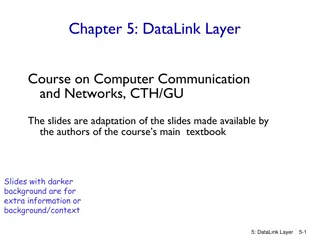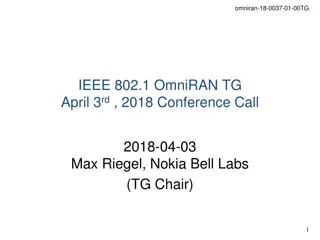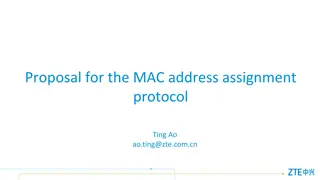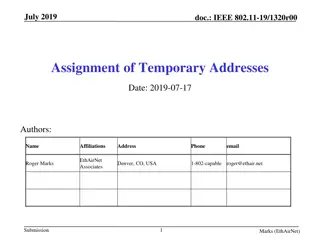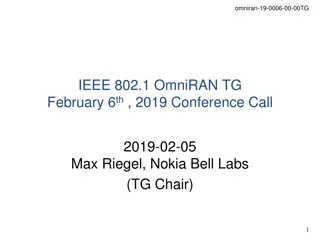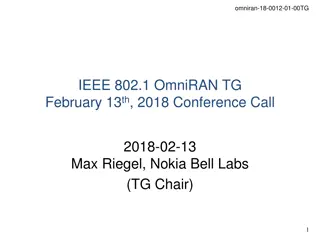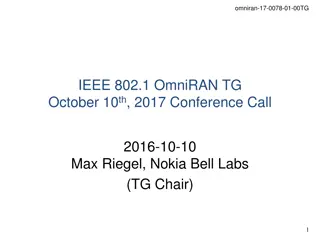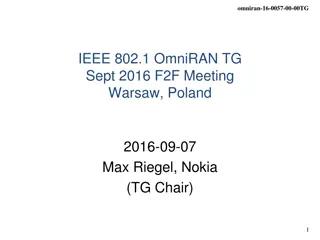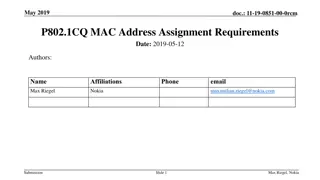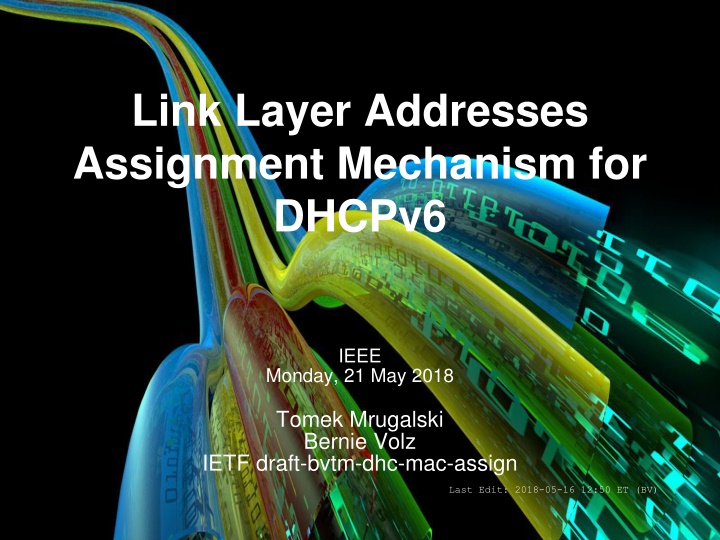
DHCPv6 Assignment Mechanism for IEEE Link Layer Addresses
"Explore the collaboration between IEEE and IETF for Link Layer Address Assignment Mechanism using DHCPv6. Learn about the background, why DHCPv6 is preferred, and use cases for MAC addresses in network environments. Dive into the considerations of random assignment and the proposed allocation scheme. Discover the benefits of leveraging existing DHCPv6 infrastructure and protocols for managing network resources efficiently."
Download Presentation

Please find below an Image/Link to download the presentation.
The content on the website is provided AS IS for your information and personal use only. It may not be sold, licensed, or shared on other websites without obtaining consent from the author. If you encounter any issues during the download, it is possible that the publisher has removed the file from their server.
You are allowed to download the files provided on this website for personal or commercial use, subject to the condition that they are used lawfully. All files are the property of their respective owners.
The content on the website is provided AS IS for your information and personal use only. It may not be sold, licensed, or shared on other websites without obtaining consent from the author.
E N D
Presentation Transcript
Link Layer Addresses Assignment Mechanism for DHCPv6 IEEE Monday, 21 May 2018 Tomek Mrugalski Bernie Volz IETF draft-bvtm-dhc-mac-assign Last Edit: 2018-05-16 12:50 ET (BV) IETF-101 DHC WG
Background (1/2) RFC 7241 defines cooperation between IEEE 802 and IETF and there are periodic discussions IEEE 802c split local MAC address space into 4 quadrants to provide for different allocation schemes IEEE 802cq is working on defining allocation mechanisms Several from IETF leadership (Ralph Droms, Russ Housley, Suresh Krishnan) thought that DHCPv6 might be usable as a MAC address allocation (802cq) mechanism 2
Background (2/2) Ralph Droms (IETF) reached out to Bernie Volz (IETF DHC WG co-chair) Tomek Mrugalski (other IETF DHC WG co-chair) and Bernie discussed and decided to work on issue Hence, the new I-D: draft-bvtm-dhc-mac-assign More background about 802c/cq in Pat Thaler s Emerging IEEE 802 Work on MAC Addressing slides from IETF-96 (https://datatracker.ietf.org/meeting/96/materials/sli des-96-edu-ieee802work-0/) 3
Why Not Randomly Assign? Number of tries 23 people Possible combinations Collision chance 49,95% No collision chance 50,05% 365 days 1024 VMs 224 (One OUI) 3,07% 96,93% 4824 VMs 224 (One OUI) 50,01% 49,99% 1M VMs 244 (Local address quadrant) 3,08% 96,92% 1M VMs 246( I know better than IEEE ) 0,71% 99,29% Birthday paradox: https://en.wikipedia.org/wiki/Birthday_problem Roughly the same probability for IPv6 uniqueness, and IPv6 does DAD Calculator: https://instacalc.com/28845 4
Use Cases for MAC addresses Hypervisor to allocate the Virtual Machines Lots of VMs May have short or long life May be possible to reuse addresses for different network segments based on data center IoT devices Often short lived/disposable Little need for global MAC address Individual clients 5
Why DHCPv6? Existing infrastructure: protocol, network, tools Servers already know how to manage and assign resources Protocol easily extensible Tomek and Bernie are in DHC WG co-chairs and 6
DHCPv6 Overview (1/4) 1. Solicit 2. Advertise Obtain 2. Advertise Client Selects Advertise B s 3. Request w/Server B s Server-ID option Ignores Request as wrong Server DUID in Server-ID option T I M E 4. Reply Client can now use address(es) and other parameters DHCPv6 Server A DHCPv6 Server B DHCPv6 Client After T1 period, client renews lifetimes 5. Renew w/Server B s Server-ID option Extend Ignores Renew as wrong Server DUID in Server-ID option 6. Reply If client no longer needs lease(s), it can release it Discard 7. Release w/Server B s Server-ID option Ignores Release as wrong Server DUID in Server-ID option 8. Reply Note: Client sends packets via link-local multicast (to FF02::1:2) Servers unicast reply to client s link-local address 7
DHCPv6 Overview (2/4) Above adds relay agent and shows minimal 2 message exchange for initial assignment Client uses IPv6 link-local address Server or relay-agent must be present on link Relay-agents forward request to servers Return path is reverse of forward path Client is not aware of relays 8
DHCPv6 Overview (3/4) DHCPv6 uses minimal packet header with lots of possible options (TLV encoded) Options are IETF/IANA assigned Options can encapsulate other options Options for assigning resources IA_NA & IAADDR for address assignment IA_PD & IAPREFIX for prefix delegation Assign multiple resources in single transaction 9
DHCPv6 Overview (4/4) Clients (and servers) identified by DUID 4 DUID types currently defined: DUID-LL based on link-layer address DUID-LLT based on link-layer address and time DUID-EN based on enterprise ID + data DUID-UUID based on UUID Server and clients must handle any DUID type 10
DHCPv6 Extensibility New options for DHCPv6 are relatively easily defined via IETF process Write an individual submission draft Get WG to adopt draft Update draft to reach rough consenus Get draft through WGLC & IESG review IANA assigns option and RFC (Request for Comments) published 11
Hence the IETF Draft Focused on Hypervisor use case where Hypervisor needs a block of MAC addresses to assign to VMs Can also be used by actual clients, but requires: IPv6 support A short-term temporary MAC address for link-local IPv6 address to request DHCPv6 assigned MAC address Client should use a non-link-layer address for DUID (DUID-EN or DUID-UUID) 12
Defines 2 New DHCPv6 Options IA_LL (Identity Association for Link Layer Addresses) Option Similar to IA_NA and IA_PD Used as container option for requested / assigned link-layer addresses LLADDR (Link Layer Addresses) Option Similar to IAADDR and IAPREFIX Used to request/assign link-layer addresses 13
IA_LL Option 0 1 2 3 0 1 2 3 4 5 6 7 8 9 0 1 2 3 4 5 6 7 8 9 0 1 2 3 4 5 6 7 8 9 0 1 +-+-+-+-+-+-+-+-+-+-+-+-+-+-+-+-+-+-+-+-+-+-+-+-+-+-+-+-+-+-+-+-+ | OPTION_IA_LL | option-len | +-+-+-+-+-+-+-+-+-+-+-+-+-+-+-+-+-+-+-+-+-+-+-+-+-+-+-+-+-+-+-+-+ | IAID (4 octets) | +-+-+-+-+-+-+-+-+-+-+-+-+-+-+-+-+-+-+-+-+-+-+-+-+-+-+-+-+-+-+-+-+ | T1 (4 octets) | +-+-+-+-+-+-+-+-+-+-+-+-+-+-+-+-+-+-+-+-+-+-+-+-+-+-+-+-+-+-+-+-+ | T2 (4 octets) | +-+-+-+-+-+-+-+-+-+-+-+-+-+-+-+-+-+-+-+-+-+-+-+-+-+-+-+-+-+-+-+-+ . . . IA_LL-options . . . +-+-+-+-+-+-+-+-+-+-+-+-+-+-+-+-+-+-+-+-+-+-+-+-+-+-+-+-+-+-+-+-+ IAID identifies instance of IA_LL option to allow for many T1 is renewal time (from now in seconds) T2 is rebinding time (from now in seconds) IA_LL-options contains one or more IA_LL options 14
LLADDR Option 0 1 2 3 0 1 2 3 4 5 6 7 8 9 0 1 2 3 4 5 6 7 8 9 0 1 2 3 4 5 6 7 8 9 0 1 +-+-+-+-+-+-+-+-+-+-+-+-+-+-+-+-+-+-+-+-+-+-+-+-+-+-+-+-+-+-+-+-+ | OPTION_LLADDR | option-len | +-+-+-+-+-+-+-+-+-+-+-+-+-+-+-+-+-+-+-+-+-+-+-+-+-+-+-+-+-+-+-+-+ | link-layer-type | link-layer-len | +-+-+-+-+-+-+-+-+-+-+-+-+-+-+-+-+-+-+-+-+-+-+-+-+-+-+-+-+-+-+-+-+ | | | link-layer-address | | | +-+-+-+-+-+-+-+-+-+-+-+-+-+-+-+-+-+-+-+-+-+-+-+-+-+-+-+-+-+-+-+-+ | extra-addresses +-+-+-+-+-+-+-+-+-+-+-+-+-+-+-+-+-+-+-+-+-+-+-+-+-+-+-+-+-+-+-+-+ | valid-lifetime | +-+-+-+-+-+-+-+-+-+-+-+-+-+-+-+-+-+-+-+-+-+-+-+-+-+-+-+-+-+-+-+-+ . . . LLaddr-options . . . +-+-+-+-+-+-+-+-+-+-+-+-+-+-+-+-+-+-+-+-+-+-+-+-+-+-+-+-+-+-+-+-+ Link-layer-type and link-layer-len specify requested link-layer address Link-layer-address specifies starting address requested or assigned Extra-address specifies number of additional addresses (0 for single address) Valid-lifetime lifetime of assignment (from now in seconds) LLaddr-options could contain future options specific to assignment | 15
Client / Server Operation (1) DHCPv6 essentials the same as address / prefix delegation But a bit simpler overall Confirm, Decline, and Information- Request client messages not used 16
Client / Server Operation (2) For hypervisor model Hypervisor is client, but does not use resulting link-layer addresses Hypervisor could obtain large blocks or one link-layer address per VM as needed Hypervisor provides link-layer address to VMs VMs could do standard DHCPv6 for IPv6 addresses/delegated prefixes or DHCPv4 17
Client / Server Operation (3) If true client (e.g. IoT) wants a link-layer address Could use Temporary MAC address for anonymity (see https://mentor.ieee.org/802.11/dcn/02/11-02- 0109-00-000i-temporary-mac-address-for- anonymity.ppt) to do DHCPv6 to get long term link-layer address assignment Clarify client must not use DUID-LL/LLT based on temporary MAC Client then uses assigned link-layer address for normal DHCPv6, DHCPv4, 18
draft-bvtm-dhc-mac-assign Status Currently an Individual Submission at IETF Changes under author control Targeted for DHC Working Group (WG) WG Adoption requires Adoption Call (authors will request shortly) If adopted, becomes WG Draft Changes under WG control (consensus) Currently no IPR claims against document 19
Next Steps Provide feedback to authors On draft itself send to the IETF DHC WG list (dhcwg@ietf.org) or email dhc-chairs@ietf.org Help resolve open issues Issue tracker Also review closed issues to confirm action? Raise new issues if needed Indicate IEEE interest in this work Authors will request IETF DHC WG adoption of the draft before IETF-102 (Montreal, July 14-20, 2018) 20
Useful Links Draft text https://datatracker.ietf.org/doc/draft-bvtm- dhc-mac-assign/ Issue tracker for Draft https://github.com/dhcwg/dhcp-mac/issues DHC mailing list (draft can be discussed here) https://www.ietf.org/mailman/listinfo/dhcwg DHC WG https://datatracker.ietf.org/wg/dhc 21
Question or comments & THANKS 22


